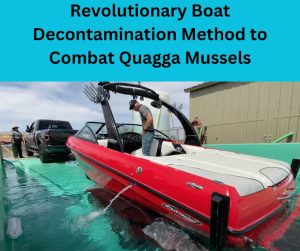
Revolutionary Boat Decontamination Method to Combat Quagga Mussels Unveiled
Utah DWR and partners introduce an innovative dip tank system at Lake Powell.
“It’s exciting to see this innovative dip tank system making waves in Utah, and it would be incredible if California agencies could explore adopting a similar approach to enhance boat decontamination and protect our waterways from invasive species.” BAM
A Game-Changing Approach to Boat Decontamination
The Utah Division of Wildlife Resources (DWR), in collaboration with Clean Wake LLC, the National Park Service at Glen Canyon National Recreation Area, and the U.S. Bureau of Reclamation, has announced a revolutionary new method to decontaminate boats and combat invasive quagga mussels. This first-of-its-kind dip tank system will be operational at Lake Powell’s Wahweap Marina on May 1.
The Inspiration Behind the Dip Tank
The concept of a dip tank system had been discussed by DWR for nearly a decade, but it wasn’t until five years ago that Garrett Atwood, founder of Clean Wake LLC, brought it to life.
“I was waiting in line at Lake Powell for a quagga mussel inspection and saw how challenging and time-consuming the process was,” Atwood said. “I thought there had to be a better way.”
After nearly a year of engineering, Atwood and the DWR aquatic invasive species team developed a patent-pending dip tank system. This innovative setup includes a tank, pumphouse, and heating and filtration system, providing a streamlined solution to the decontamination process.
How the Dip Tank Works
The dip tank eliminates the need for staff to manually spray boats, simplifying the process for both inspectors and boaters. Key features include:
- Efficient Cleaning: Boats back into a 14-foot wide, 5-foot deep tank of 110-degree water, which flushes complex intake systems.
- Built-In Guides: Tracks assist boaters in properly positioning their watercraft.
- Advanced Filtration: A pump system cycles the water every two hours to keep it clean.
- Quick Process: The entire decontamination takes only about five minutes.
“This system will enhance our efforts to stop the spread of quagga mussels,” said DWR Aquatic Invasive Species Coordinator Nate Owens. “It’s faster, more effective, and less damaging to boats. We are thrilled to partner with Clean Wake LLC, the National Park Service, and other agencies to bring this innovation to life.”
Free Decontamination Options for Boaters
The dip tank will primarily serve wakeboard boats with complex systems, while traditional hot-water decontaminations will remain available for other watercraft. Both options are free for boaters.
Essential Boater Reminders
To protect Utah’s waterways, all watercraft users must comply with inspection and decontamination protocols:
- Mandatory Inspections: Stop at open aquatic invasive species inspection stations after leaving any waterbody. Failure to comply is a class B misdemeanor.
- Self-Decontamination:
- Clean: Remove all debris, including plant material and mussel fragments, from your boat.
- Drain: Pull all drain plugs and empty water from ballast tanks, bilges, and live wells.
- Dry: Allow your boat to dry for at least 30 days if not professionally decontaminated.
Preventing an Economic and Environmental Crisis
“Invasive quagga mussels pose a severe threat to Utah’s water delivery systems, potentially costing millions of dollars annually,” said Bruce Johnson, DWR statewide operations lieutenant. “We urge boaters to comply with inspections and decontamination to prevent utility cost increases and ecological damage.”
$20 Fee for Out-of-State Boats
Motorized boats not registered in Utah must pay a $20 fee to operate in the state. Boaters must complete an online education course on quagga mussel prevention before paying the fee. Visit the STD of the Sea website for more information.
A Collaborative Effort for Cleaner Waters
The new dip tank system marks a significant milestone in the fight against invasive species. Thanks to the ingenuity of Clean Wake LLC and the support of partnering agencies, Lake Powell is leading the charge in protecting Utah’s waterways for generations to come.
Credit Utah Division of Wildlife Resources
Discover the ultimate resource for bass fishing enthusiasts with Bass Angler Magazine! Packed with expert tips, the latest cutting-edge techniques, and in-depth articles, our magazine is your go-to guide for mastering the art of bass fishing. Whether you’re a seasoned pro or just getting started, Bass Angler Magazine delivers the insights and inspiration you need to reel in the big ones. Subscribe today and elevate your angling game!


